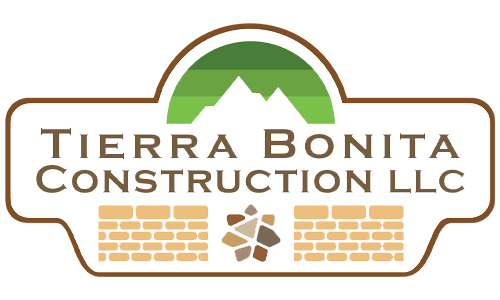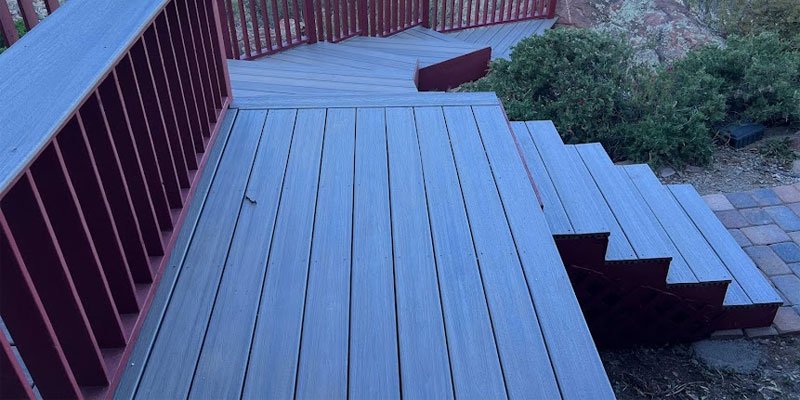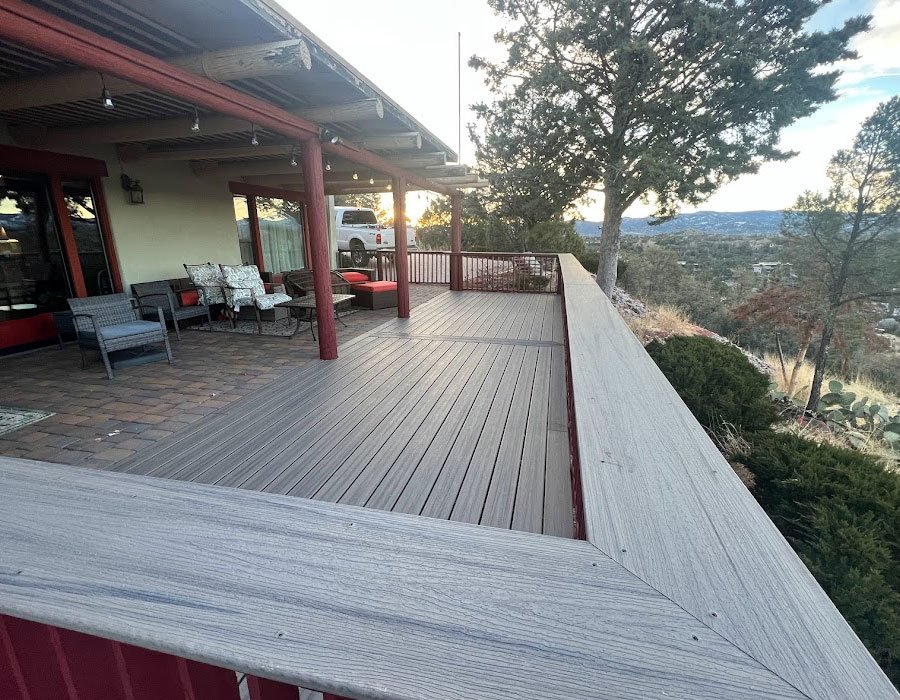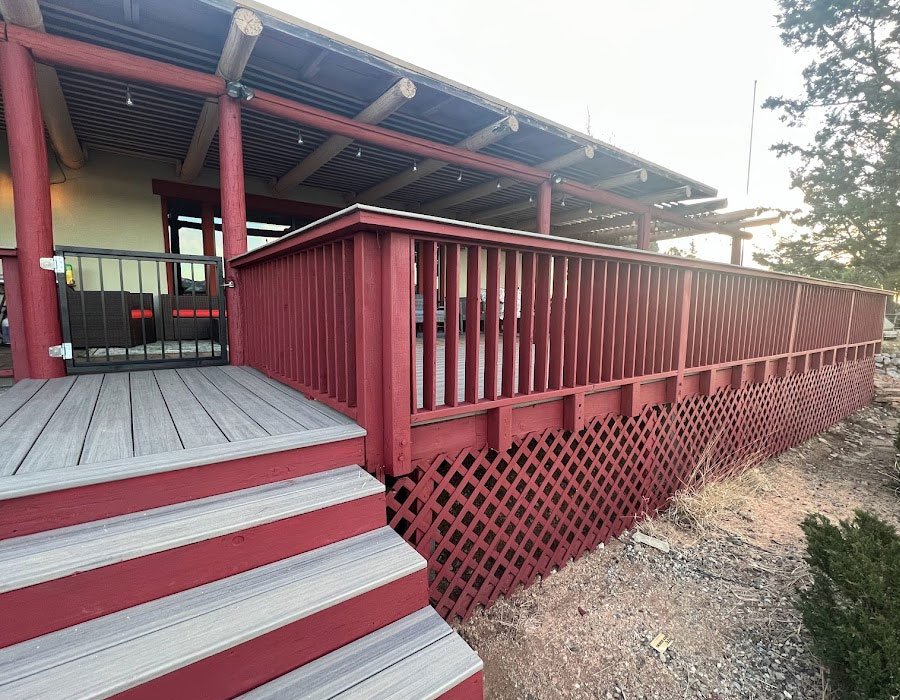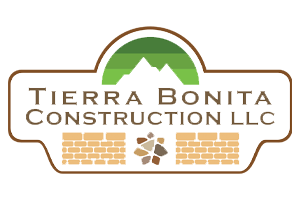Frequently Asked Questions
What materials do Boston deck builders recommend for durable outdoor decks?
Boston deck builders recommend materials such as composite decking, pressure-treated wood, and tropical hardwoods for durable outdoor decks. These options provide excellent resistance to weather, pests, and wear, ensuring longevity and minimal maintenance.
What types of wood are best for decks?
The best types of wood for decks include cedar, redwood, and pressure-treated pine, as they offer durability, resistance to decay, and aesthetic appeal, making them ideal choices for outdoor installations.
How long do composite decks typically last?
Composite decks typically last 25 to 30 years with proper maintenance. Their durability and resistance to fading, staining, and insects make them a long-lasting choice for outdoor spaces.
What is the cost of deck installation?
The cost of deck installation varies based on materials, size, and design complexity. On average, homeowners in Prescott, Arizona, can expect to spend between $15 to $35 per square foot. For a precise quote, contact Tierra Bonita Construction.
Are there eco-friendly materials for decks?
Eco-friendly materials for decks include recycled wood, composite materials made from recycled plastics, and sustainably sourced hardwoods. These options not only reduce environmental impact but also offer durability and aesthetic appeal for your outdoor space.
How to maintain a wood deck properly?
Proper maintenance of a wood deck involves regular cleaning, sealing, and inspection. Clean the deck with a gentle soap and water solution, apply a sealant every few years, and check for damage or rot to ensure longevity and safety.
What design options are available for decks?
The design options available for decks include various styles such as traditional, contemporary, and custom layouts, along with choices in materials like wood, composite, and PVC, allowing for personalized aesthetics and functionality to suit any home.
How do weather conditions affect deck materials?
Weather conditions significantly affect deck materials by influencing their durability and maintenance needs. Extreme temperatures, moisture, and UV exposure can lead to warping, fading, or deterioration, making it essential to choose materials suited for Prescott's climate.
What is the best finish for outdoor decks?
The best finish for outdoor decks is a high-quality sealant or stain that protects against moisture and UV damage while enhancing the wood's natural beauty. Look for products specifically designed for outdoor use to ensure durability and longevity.
How to choose a deck builder in Arizona?
Choosing a deck builder in Arizona involves evaluating their experience, customer reviews, and portfolio. Ensure they offer quality materials, transparent pricing, and a commitment to customer satisfaction to guarantee a successful deck installation.
What permits are needed for deck construction?
The permits needed for deck construction typically include a building permit and may also require zoning approval, depending on local regulations in Prescott, Arizona. It's essential to check with your local government for specific requirements.
How to enhance deck safety features?
Enhancing deck safety features involves installing guardrails, ensuring proper lighting, using non-slip materials, and maintaining regular inspections. These measures help prevent accidents and create a secure outdoor space for family and guests.
What are the benefits of composite decking?
The benefits of composite decking include its durability, low maintenance, and resistance to fading, staining, and insects. Additionally, it offers a variety of colors and styles, making it an attractive choice for outdoor spaces.
How to prevent deck warping and cracking?
Preventing deck warping and cracking involves proper maintenance and material selection. Use high-quality, weather-resistant materials, apply protective sealants, and ensure proper ventilation and drainage to minimize moisture accumulation. Regular inspections and timely repairs also help maintain deck integrity.
What is the average size of a deck?
The average size of a deck typically ranges from 200 to 400 square feet, depending on the home's layout and the homeowner's preferences. This size allows for comfortable outdoor living space while accommodating furniture and activities.
How to incorporate lighting into deck design?
Incorporating lighting into deck design enhances both aesthetics and safety. Consider using built-in LED lights, post cap lights, or string lights to illuminate pathways and create a warm ambiance for evening gatherings.
What are common deck installation mistakes?
Common deck installation mistakes include improper measurements, inadequate support structures, neglecting to account for drainage, and using low-quality materials. These errors can lead to safety issues and costly repairs, so careful planning and execution are essential.
How to choose colors for deck materials?
Choosing colors for deck materials involves considering the overall aesthetic of your home, the surrounding landscape, and the desired mood. Opt for shades that complement your exterior and create a harmonious look while also factoring in durability and maintenance.
What is the best time for deck installation?
The best time for deck installation is typically during the spring or early fall when weather conditions are mild and dry. This allows for optimal curing of materials and ensures a smooth installation process.
How to ensure proper drainage for decks?
Ensuring proper drainage for decks involves designing a slight slope away from the house, using drainage systems like gutters or downspouts, and selecting materials that allow water to flow through. Regular maintenance is also key to prevent water buildup.
What are the latest trends in deck design?
The latest trends in deck design include the use of sustainable materials, multi-level configurations, and integrated outdoor living spaces that blend seamlessly with nature, providing both functionality and aesthetic appeal.
How to add privacy to an outdoor deck?
Adding privacy to an outdoor deck can be achieved through various methods. Consider installing privacy screens, tall planters with dense foliage, or trellises with climbing plants to create a secluded space while enhancing the aesthetic appeal.
What maintenance is required for composite decks?
The maintenance required for composite decks includes regular cleaning to remove dirt and debris, occasional rinsing with soap and water, and checking for any loose boards or fasteners. This helps ensure longevity and optimal appearance.
How to select railings for outdoor decks?
Selecting railings for outdoor decks involves considering safety, style, and material durability. Choose railings that complement your deck design, meet local building codes, and are made from weather-resistant materials to ensure longevity and aesthetic appeal.
What are the advantages of pressure-treated wood?
The advantages of pressure-treated wood include enhanced durability, resistance to rot and insects, and extended lifespan, making it an ideal choice for outdoor structures like decks in Prescott, Arizona.
How to create a multi-level deck design?
Creating a multi-level deck design involves planning distinct levels for functionality and aesthetics. Start by assessing your space, then sketch a layout that incorporates stairs, railings, and seating areas, ensuring a seamless flow between levels.
What accessories enhance outdoor deck functionality?
Accessories that enhance outdoor deck functionality include built-in storage benches, outdoor lighting, and weather-resistant furniture. These elements improve usability, safety, and ambiance, making your deck a more enjoyable and versatile space.
How to budget for a deck project?
Budgeting for a deck project involves estimating costs for materials, labor, and permits. Begin by researching material prices, considering design options, and obtaining quotes from contractors to ensure a realistic budget that aligns with your vision and financial capacity.
What are the best practices for deck construction?
The best practices for deck construction include ensuring proper planning and design, selecting high-quality materials, maintaining adequate drainage, and following local building codes. Additionally, regular maintenance and inspections will enhance the deck's longevity and safety.
How to choose between wood and composite decking?
Choosing between wood and composite decking involves considering factors like durability, maintenance, and aesthetics. Wood offers a natural look but requires regular upkeep, while composite is low-maintenance and resistant to weathering, making it a practical choice for long-term use.
